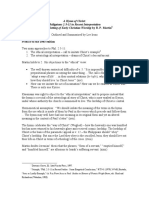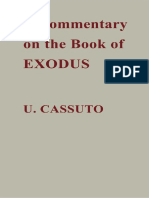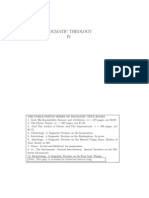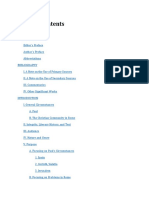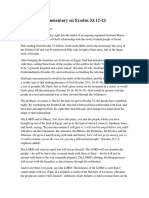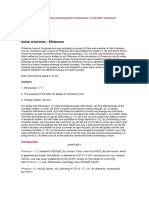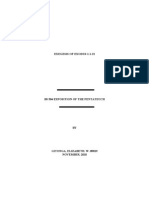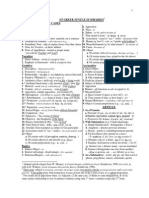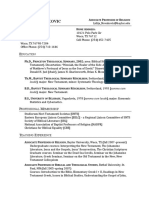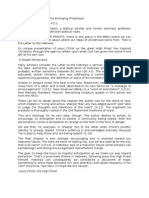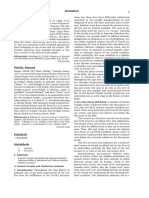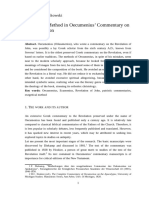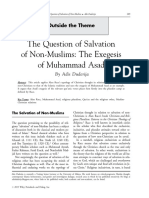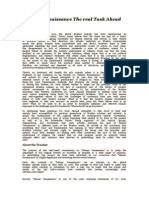Epexegesis - Vanhoye On Hebrews PDF
Epexegesis - Vanhoye On Hebrews PDF
Uploaded by
luizhtdCopyright:
Available Formats
Epexegesis - Vanhoye On Hebrews PDF
Epexegesis - Vanhoye On Hebrews PDF
Uploaded by
luizhtdOriginal Title
Copyright
Available Formats
Share this document
Did you find this document useful?
Is this content inappropriate?
Copyright:
Available Formats
Epexegesis - Vanhoye On Hebrews PDF
Epexegesis - Vanhoye On Hebrews PDF
Uploaded by
luizhtdCopyright:
Available Formats
Vanhoye on Hebrews
In the book, Structure and Message of the Epistle to the Hebrews, Albert Vanhoye offers a detailed analysis of the
structure of that very important, and often misunderstood, epistle. He posits the following chiastic structure for
Hebrews1:
I The Name of Christ 1:5-2:18
II A. Jesus high priest worthy of faith 3:1-4:14
II B. Jesus merciful high priest 4:15-5:10
-- Preliminary exhortation 5:11-6:20
III A. High Priest after the manner of Melchizedek 7:1-28
III B. Made perfect 8:1-9:28
III C. Cause of an eternal salvation 10:1-18
-- Final exhortation 10:19-39
IV A. The faith of the ones of old 11:1-40
IV B. The necessary endurance 12:1-13
V The straight paths 12:14-13:21
David L. Allen, Dean of the School of Theology at Southwestern Baptist Theological Seminary and author of two books
relating to the exegesis of Hebrews (the Lukan Authorship of Hebrews and The New American
Commentary: Hebrews), praises Vanhoye for his scholarly contribution, particularly because it launched the modern quest
for the structure of Hebrews.2 In this post, I want to express my gratitude as well for Vanhoyes highly detailed and
extensive work on this subject, but I especially want to focus upon one critical observation of his work which is often
overlooked in biblical commentaries, an observation which has also helped launch my own quest into understanding the
primary message of Hebrews. The critical observation of Vanhoyes which I want to focus upon is that he marks the very
center of the entire epistle as chapter 8:1 through 9:28 (notice section III, subsection B, titled Made perfect).
Have you ever viewed chapters 8 and 9 as the very center of Hebrews, or as the main focal point of the entire
epistle?
The general outline above is only the first step toward recognizing that there is a central focal point to the entire letter.
Further into his book, Vanhoye breaks down the center of the entire epistle (8:1-9:28) into smaller literary units, showing
that, not only is the entire letter structured chiasticaly, but more importantly, the central section is itself structured
chiastically, which no other literary unit within the epistle shares in common.
Below is a sketch of my own observations concerning the central chiasm of the entire epistle to the Hebrews. The
structure is similar to Vanhoyes outlines, but I have tweaked them a bit, and for those who have Vanhoyes books on
Hebrews to compare,3 the outline below is clearly different in a couple verse breaks as well in all of the descriptions (for
Vanhoye uses some scholastically nebulous jargon in a many of his descriptions):
A. Hebrews 8:1-5
B. Hebrews 8:6-13
C. Hebrews 9:1-10
C. Hebrews 9:11-14
B. Hebrews 9:15-22
A. Hebrews 9:23-284
A. The temporal, earthly level at which the Old Covenant priestly ministry of the Levites takes place (8:1-5)
B. Gods covenant with man and its association with the old and temporal ministry of mediation by the Levitical
Priesthood (8:6-13)
C. The organization of the old ministry and the unsatisfactory nature of priestly service in Gods
House as illustrated in the earthly priests need to continually enter through "the first tent", but only
through the "second" tent once every year (9:1-10)
C. The organization of Christs ministry and the satisfactory nature of priestly service in Gods House
because Jesus entered through the greater and more perfect tent, thereby
obtaining "eternal redemption" (9:11-14)
B. Gods covenant with man and its association with the new and eternal priestly ministry of mediation by
Jesus (9:15-22)
A. The eternal, heavenly level at which the New Covenant priestly ministry of Jesus Christ takes place (9:23-28)
There are a number of valuable insights to be noted within this central section of Hebrews, but I will have to save quite a
few of them for another post. For now, I want to highlight two things: First, notice that the central section of Hebrews is
focused entirely upon the transition of one priesthood to another. The author illustrates this transition with a variety of
parallel themes:
1. Transition from a temporary ministry of redemption to Jesus having obtained eternal redemption
2. Transition from an old covenant ministry to a new covenant ministry
3. And most importantly (by way of the central illustration), the laws pertaining to Levitical priests to enter through
the first tent continually, with the high priest only entering the second tent once a year, was symbolic (literally "a
parable" in Greek) of the unsatisfactory nature of the first (or "old") covenant ministry and the eventual need for a
transition into a second, truly satisfactory ministry. Jesus entered through the greater tent to obtain, once for all
time, eternal redemption, which the continual offering of Levitical priests could never accomplish. Therefore,
Jesus accomplished a truly satisfactory ministry, and is truly the High Priest.
And secondarily, notice that all of the theological jargon surrounding the use of covenant is intrinsically related to the
ministry of the priesthood as established in Mosaic law, which the author says in sections C and C is a parable for the
present age (9:9). This means, at the time in which the author lived and wrote this epistle, there was an age or period
of transition where the old and first ministry was becoming obsolete and growing old, ready to vanish away (8:13).
With this in mind, Vanhoyes comments seem to make a good finishing touch to this discussion. He writes:
The most meaningful subdivisions are those of the center, for they treat the main subject matter: the
sacrificial activity itself. The author recalls the old system of ritual separations A sacred place has been
established. It consists of a holy part, the first tent (9:2), and a most holy part (9:3), thought to be the
dwelling place of God or sanctuary. The people are not allowed to enter in either for they do not have the
holiness needed. The priests may enter into the first tent (9:6) which is like the way of access to the
sanctuary, but they may not enter in to the latter. Only the high priest is authorized to do that, by reason
of his special consecration, but even he functions under severe restrictions: he must limit his entrance to
once a year, and the condition for entering is a sacrificial offering (9:7). The ceremony to which the author
alludes is that of the Day of Expiation (Yom Kippur, Lev. 16), the high point of the Jewish liturgy.
The question which suggests itself is the mediation value of this solemn liturgy. From this depends the
judgment to be given about the system as a whole. If an authentic relation is established with God, then the
system is excellent. But if the contrary is true, then it can only constitute a provisional solution, one to be
set aside as soon as a better one is found.
The first tent, unfortunately, was unable to provide access [to the dwelling of God] A conclusion follows:
the way of the sanctuary was still not manifest as long as the first tent existed (9:8).5
1. Albert Vanhoye, Structure and Message of the Epistle to the Hebrews [Editrice Pontificio Istituto Biblico; Roma Italia, 1989] p. 33
2. David L. Allen, Lukan Authorship of Hebrews (NAC Studies in Bible & Theology)[B&H Academic; Nashville, TN; 2010] p. 163
3. He has two great books on the subject of Hebrews: Albert Vanhoye, Structure and Message of the Epistle to the Hebrews [Editrice Pontificio Istituto Biblico;
Roma Italia, 1989] pp. 36, 63-69, 92-95; and Albert Vanhoye, A Different Priest: The Epistle to the Hebrews [Convivium Press; Miami, Fl, 2011] pp. 225-258
4. Ibid. p. 225
5. Ibid. pp. 63-64
You might also like
- Gordon Fee 2 Corinthians CommentaryDocument3 pagesGordon Fee 2 Corinthians CommentaryAdam100% (2)
- LANDOW George P (1991) Hypertext The Convergence of Contemporary Critical Theory and TechnologyDocument256 pagesLANDOW George P (1991) Hypertext The Convergence of Contemporary Critical Theory and TechnologyCarla Uzcátegui RondónNo ratings yet
- The Critical Edition of Q - A Synopsis Including The Gospels of Matthew and Luke, Mark and Thomas - Hermeneia SeriesDocument700 pagesThe Critical Edition of Q - A Synopsis Including The Gospels of Matthew and Luke, Mark and Thomas - Hermeneia SeriesJersonneto100% (3)
- Literary - Structure - Isaiah-By Kickert PDFDocument20 pagesLiterary - Structure - Isaiah-By Kickert PDFHongweiNo ratings yet
- Reflections On The Authorship of Peter: Michael GilmourDocument19 pagesReflections On The Authorship of Peter: Michael Gilmourjoenarhl17No ratings yet
- 1982 Gundry On MattDocument11 pages1982 Gundry On Mattxal22950100% (2)
- A Hymn of Christ - R. P. MartinDocument13 pagesA Hymn of Christ - R. P. MartinDaniel Rodríguez100% (1)
- A Commentary On The Book of ExodusDocument527 pagesA Commentary On The Book of ExodusRajeshwari Malli94% (17)
- ROMANS 1 18 AS KEY TO ΤΗE STRUCTURE OF THE LETTERDocument15 pagesROMANS 1 18 AS KEY TO ΤΗE STRUCTURE OF THE LETTERchristian8petrusNo ratings yet
- Saint John Chrysostom - Homilies On Genesis 1-17Document255 pagesSaint John Chrysostom - Homilies On Genesis 1-17Alexander Parker100% (2)
- Is Acts 2,38 Against The Salvific Meaning of BaptismDocument0 pagesIs Acts 2,38 Against The Salvific Meaning of BaptismnoquierodarinforNo ratings yet
- ChristologyDocument193 pagesChristologygeoffhorton100% (1)
- Word Studies in The New Testament - Vol 1 & 2 (Marvin R Vincent) PDFDocument1,413 pagesWord Studies in The New Testament - Vol 1 & 2 (Marvin R Vincent) PDFPatricia Jorge De Carvalho Felix100% (1)
- Ephesians Commentary PDFDocument24 pagesEphesians Commentary PDFSathya Poorani100% (2)
- Divine Wrath and Salvation in Matthew: The Narrative World of the First GospelFrom EverandDivine Wrath and Salvation in Matthew: The Narrative World of the First GospelRating: 4.5 out of 5 stars4.5/5 (2)
- The Epistle To The Romans (New International Commentary)Document1,046 pagesThe Epistle To The Romans (New International Commentary)FredMotta100% (1)
- 2 - Ephesians and Colossians ComparisonDocument10 pages2 - Ephesians and Colossians ComparisonBible_lover_Bill100% (1)
- Commentary On Exodus 33.12-23.schifferdeckerDocument3 pagesCommentary On Exodus 33.12-23.schifferdeckergcr1974No ratings yet
- Abduh IDocument112 pagesAbduh IAhmad YusryNo ratings yet
- Kaiser, Psalm 72 An Historical and Messianic Current Example of Antiochene Hermeneutical TheoriaDocument15 pagesKaiser, Psalm 72 An Historical and Messianic Current Example of Antiochene Hermeneutical TheoriatheoarticlesNo ratings yet
- James' Use of Amos at The Jerusalem Council (Acts 15) (M.a. Braun)Document8 pagesJames' Use of Amos at The Jerusalem Council (Acts 15) (M.a. Braun)spaghettipaulNo ratings yet
- Jamieson, R. B. (2020) - 1 Corinthians 15.28 and The Grammar of Paul's Christology. New Testament Studies, 66 (2), 187-207Document21 pagesJamieson, R. B. (2020) - 1 Corinthians 15.28 and The Grammar of Paul's Christology. New Testament Studies, 66 (2), 187-207Zdravko JovanovicNo ratings yet
- Exegesis PDFDocument2 pagesExegesis PDFRicardy100% (1)
- Matthew Bible Study by Craig KeenerDocument32 pagesMatthew Bible Study by Craig KeenerKevin Duplechin100% (1)
- Mark Dubis - Research On 1 Peter - Petru 15, 3Document41 pagesMark Dubis - Research On 1 Peter - Petru 15, 3windorinNo ratings yet
- HICKS, Tom. Benjamin Keach's Doctrine of JustificationDocument21 pagesHICKS, Tom. Benjamin Keach's Doctrine of JustificationNatan LeiteNo ratings yet
- Short Study: Jack CollinsDocument8 pagesShort Study: Jack CollinsRazia MushtaqNo ratings yet
- 2nd Peter Exegetical PaperDocument6 pages2nd Peter Exegetical PaperJimmy CreechNo ratings yet
- Another Look at Pistis ChristouDocument17 pagesAnother Look at Pistis Christouakimel100% (1)
- An Exegetical Summary of 1, 2, 3 JohnDocument198 pagesAn Exegetical Summary of 1, 2, 3 Johnkrocksldyfueg100% (4)
- ELLINGWORTH, Paul. Jesus and The Universe in Hebrews PDFDocument14 pagesELLINGWORTH, Paul. Jesus and The Universe in Hebrews PDFwelvisdouglas100% (1)
- Penal Substitution in Church HistoryDocument16 pagesPenal Substitution in Church HistoryDavid Salazar100% (1)
- Lipscomb - RomansDocument298 pagesLipscomb - RomansDan B HodgeNo ratings yet
- Philemon 1 - Meyer's Critical and Exegetical Commentary On The New TestamentDocument17 pagesPhilemon 1 - Meyer's Critical and Exegetical Commentary On The New TestamentLeonardo AlvesNo ratings yet
- Romans 9-14-18 and John Piper S The JustDocument24 pagesRomans 9-14-18 and John Piper S The JustJamal DookhyNo ratings yet
- Introduction To The Book of ZechariahDocument12 pagesIntroduction To The Book of ZechariahrodelNo ratings yet
- Election and Foreknowledge: The Believer's Magazine, Vol. 65, July 1955Document19 pagesElection and Foreknowledge: The Believer's Magazine, Vol. 65, July 1955brethren_history100% (1)
- Bibliography of PhilemonDocument9 pagesBibliography of PhilemonRobert Carlos CastilloNo ratings yet
- 1 Chronicles: Notes OnDocument43 pages1 Chronicles: Notes OnShawki Shehadeh100% (1)
- Methodist - Theology-Randy Johns PDFDocument5 pagesMethodist - Theology-Randy Johns PDFStefan PsaltulNo ratings yet
- The Narrative Meaning and Function of The Transfiguration of JesusDocument15 pagesThe Narrative Meaning and Function of The Transfiguration of JesusDavid Gerardo Ortiz MartinezNo ratings yet
- Unexpected Light On Heb 13.1-6Document9 pagesUnexpected Light On Heb 13.1-631songofjoyNo ratings yet
- Exegesis of Exodus 1-1-22 - Elizabeth Gitonga (With Commentaries)Document19 pagesExegesis of Exodus 1-1-22 - Elizabeth Gitonga (With Commentaries)Elizabeth GitongaNo ratings yet
- Trench-Synonyms of New Testament (2) - 1866 PDFDocument208 pagesTrench-Synonyms of New Testament (2) - 1866 PDFphilologus100% (1)
- NT Greek Syntax Summary SheetDocument4 pagesNT Greek Syntax Summary SheetElijahDolbear100% (1)
- Indicators of Typology Within The Old Testament (The Exodus Moti) - F. Ninow PDFDocument372 pagesIndicators of Typology Within The Old Testament (The Exodus Moti) - F. Ninow PDFFelipe LopesNo ratings yet
- (Peter D. Miscall) Isaiah (Readings, A New Biblica PDFDocument186 pages(Peter D. Miscall) Isaiah (Readings, A New Biblica PDFOláh Pál Olivér100% (5)
- Against The Gods: The Polemical Theology of The Old TestamentDocument7 pagesAgainst The Gods: The Polemical Theology of The Old TestamentJohnNo ratings yet
- 2 Corinthians CommentaryDocument34 pages2 Corinthians Commentarytheoak1678No ratings yet
- 01 Biblical Greek Language and Linguistics PDFDocument149 pages01 Biblical Greek Language and Linguistics PDFJosh Bloor100% (2)
- Dual Authorship and The Single Intended Meaning of ScriptureDocument5 pagesDual Authorship and The Single Intended Meaning of ScriptureNazim DjedaaNo ratings yet
- Defining Deponency An InvestiDocument329 pagesDefining Deponency An Investi321876No ratings yet
- The Shape of The Psalter and The Lord SDocument34 pagesThe Shape of The Psalter and The Lord SJose Miguel Alarcon CuevasNo ratings yet
- Review Davids, Peter H., The Letters of 2 Peter and JudeDocument2 pagesReview Davids, Peter H., The Letters of 2 Peter and Judegersand6852No ratings yet
- Ekklasia Part 1Document27 pagesEkklasia Part 1Luis Azañero100% (1)
- FulltextDocument87 pagesFulltextHugo Martin100% (1)
- Book Report On Re-Reading The Bible With New Eyes.: Biblical Hermeneutics: Methods and PerspectivesDocument5 pagesBook Report On Re-Reading The Bible With New Eyes.: Biblical Hermeneutics: Methods and PerspectivesNIMSHI MCC100% (1)
- Idija Ovakovic: DucationDocument10 pagesIdija Ovakovic: DucationWUISTON MEDINANo ratings yet
- The Book of Joel 2022 EditionDocument52 pagesThe Book of Joel 2022 EditionDavid EinsteinNo ratings yet
- Letter To Hebrews The Emerging PriesthoodDocument6 pagesLetter To Hebrews The Emerging PriesthoodWina Rindra CahyantiNo ratings yet
- 2 Corinthians (NT), CommentaryDocument77 pages2 Corinthians (NT), CommentaryJesus LivesNo ratings yet
- Facts vs. Tulip ChartDocument3 pagesFacts vs. Tulip Chartrchover1No ratings yet
- How Should We Understand 1 John 3-4-10Document15 pagesHow Should We Understand 1 John 3-4-10benmarxNo ratings yet
- ColDocument75 pagesColapi-303640034No ratings yet
- 2 ChroniclesDocument41 pages2 Chroniclesxal22950100% (1)
- Scriptural Authority and Biblical Criticism in the Dutch Golden Age Dick Van Miert download pdfDocument62 pagesScriptural Authority and Biblical Criticism in the Dutch Golden Age Dick Van Miert download pdfsungyambwa100% (1)
- Dada 2010Document16 pagesDada 2010Vanlal RuataNo ratings yet
- RMorgan - NTT Since BultmannDocument9 pagesRMorgan - NTT Since Bultmannkansas07No ratings yet
- Quran Tafseer Al-Sadi para 30 UrduDocument97 pagesQuran Tafseer Al-Sadi para 30 Urduapi-3782112100% (16)
- Block Diagram InstructionsDocument2 pagesBlock Diagram InstructionsJNo ratings yet
- Commentary Into The Light of The Holy Qur039an Vol. 19Document328 pagesCommentary Into The Light of The Holy Qur039an Vol. 19Sanam ZahraNo ratings yet
- Halakhah Modern Judaism From The EncycloDocument16 pagesHalakhah Modern Judaism From The EncycloWilian CardosoNo ratings yet
- At The Mountain of God - Story and Theology in Exodus 32-34 PDFDocument259 pagesAt The Mountain of God - Story and Theology in Exodus 32-34 PDFNichifor Tanase100% (1)
- Wojciechowski Oecumenius Annali FinalDocument10 pagesWojciechowski Oecumenius Annali FinalMichał WojciechowskiNo ratings yet
- 153Document19 pages153Tom DavisNo ratings yet
- The Question of Salvation of Non MuslimsDocument9 pagesThe Question of Salvation of Non MuslimsMuhammad KhalidNo ratings yet
- Sefer Ha OlamDocument112 pagesSefer Ha Olamastrojin100% (1)
- Preaching To A Post-Modern WorldDocument11 pagesPreaching To A Post-Modern WorldDavid Salazar100% (2)
- (Culture and Civilization in The Middle East) Hussein Abdul-Raof - Theological Approaches To Qurâ ™anic Exegesis - A Practical Comparative-Contrastive Analysis-Routledge (2012)Document305 pages(Culture and Civilization in The Middle East) Hussein Abdul-Raof - Theological Approaches To Qurâ ™anic Exegesis - A Practical Comparative-Contrastive Analysis-Routledge (2012)Ali AghaNo ratings yet
- ThMThesis DivorceDocument95 pagesThMThesis Divorcejoefact100% (1)
- SBJT 21.1 BT Exegeis Typology Sequeira EmadiDocument24 pagesSBJT 21.1 BT Exegeis Typology Sequeira Emadiasher786100% (1)
- Boeckh - Philological HermeneuticsDocument16 pagesBoeckh - Philological HermeneuticsMondlTNo ratings yet
- Aspects of Christ Epinoiai Christou in Origens Commentary On The Epistle To The RomansDocument22 pagesAspects of Christ Epinoiai Christou in Origens Commentary On The Epistle To The Romansstefan pejakovićNo ratings yet
- Zechariah NICOT ReviewDocument3 pagesZechariah NICOT ReviewJeremiah ZuoNo ratings yet
- Plato ChristianusDocument32 pagesPlato ChristianusLaertiana100% (1)
- BASIC PRINCIPLES FOR BIBLICAL INTERPRETATION (PDFDrive) PDFDocument72 pagesBASIC PRINCIPLES FOR BIBLICAL INTERPRETATION (PDFDrive) PDFJefferson JesusNo ratings yet
- Psalm 1 An Isagogic Exegetical and TheolDocument10 pagesPsalm 1 An Isagogic Exegetical and TheolkblytheNo ratings yet
- Job and Isaiah 40 55 Intertextualities PDFDocument31 pagesJob and Isaiah 40 55 Intertextualities PDFDaniel ConstantineNo ratings yet
- C2. TE Classification Complete WEB VDocument59 pagesC2. TE Classification Complete WEB VPaulCJBurgessNo ratings yet
- Islamic Renaissance-The Real Task AheadDocument61 pagesIslamic Renaissance-The Real Task AheadMuhammad Azam KhalidNo ratings yet






